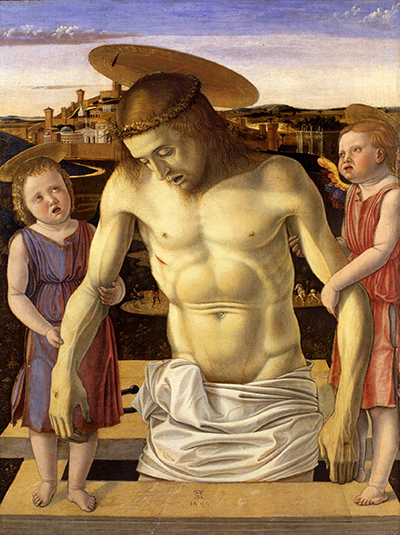Giovanni Bellini a great Renaissance painter from Italy created the Christian art of dead Christ supported by two Angels between 1453 and 1455.
The portrait shows how the naked body of Christ who had been crucified seated while leaning backward is being supported by the two angles. The angles are on either side holding the hand of the lifeless body of Christ they are so close that their faces touch the head of Christ a bit.
Giovanni had earlier created two similar painting in a landscape format but on these paintings Christ was being supported by four angles. They were abandoned because they were thought to be bizarre but one is in National Gallery in London and the other one is being housed in Pinacoteca Comunale. When unusual interpretation were made about the two paintings he corrected by using an upright format and using only two angles. In the painting he brought out how the physical human body is accepted completely in the spiritual world this is how he painted the angles gently touching the arms of the dead body and even leaning on Him. The graphic in the portrait balanced with the theme the use of soft curves that at the same time look vigorous made the painting to look more prominent.
The painting of the dead Christ being supported by the two angles was among his early arts together with those in Accademia Carrara and Museo Poldi Pezzoli in Bergamo and Milan respectively. While creating this painting he kept retaining to his previous theme of Madonna and the lamentation. It aided him in the painting as he carefully studied how you could combine nudeness with silent pain look. Using this representation together with his skills he was able to paint an art that gave a clear picture of new spiritual reams. This accorded him more respect in painting since no artist had achieved to bring the theme of spiritual world clearly.
The painting was put on top of the polyptych register. It shared Andrea Mantegna his bother in-law style. Giovanni was motivated by the sculptural work of an artist in Padua called Donatello. In 1499 when Albrecht Dürer visited Venice he was moved by Giovanni work that he wrote his initial on the work that said Giovanni was the greatest painter of them all. The sculpture is now kept in Museo Correr in Venice.




